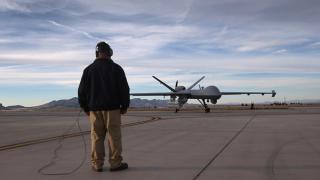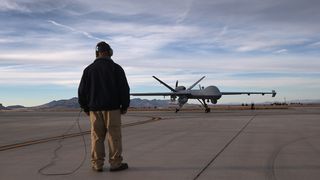The aerial strikes on oil facilities in Saudi Arabia last weekend offer a glimpse of the future of warfare.
The largest disruption of global oil supplies on record wasn’t caused by a bomber strike or fast jet raid. Instead, the devastating attack, which cut oil production and rocked energy markets, was brought about by the precise deployment of an unmanned swarm of low-cost drones and cruise missiles.
The attack most likely came from territory controlled by Iran or its proxies, which have been investing in low-cost drone technology for the past decade. But the use of cheap and lethal unmanned (and often unattributable) weaponry is spreading beyond nation states and prompting significant changes in the way advanced militaries undertake their own defence procurement. It could have far-reaching consequences for the way Australia invests its defence budget.
But the use of cheap and lethal unmanned (and often unattributable) weaponry is spreading beyond nation states and prompting significant changes in the way advanced militaries undertake their own defence procurement.
Recent conflicts in the Middle East have provided a battle lab for the testing and development of cheap, improvised drone technology. By reverse-engineering captured US and Israeli drones, Iran has built its own fleets and deployed them across the region – through its own forces in Syria and via its proxies in Yemen, Lebanon and Iraq.
Early last year, Israel destroyed more than 10 aircraft at a large drone base near Palmyra in Syria controlled by Iran’s Revolutionary Guards. Last October, Iran was accused of using a mix of drones and cruise missiles to attack targets in eastern Syria. In March, an Iranian military drill in the Strait of Hormuz claimed to deploy up to 50 drones; and in July, Iranian drones were shot down while confronting US Navy ships transiting the strait.
One reason for the rapid development of these drones is that they are cheap and, unlike so much other military hardware, easily available. Some of the components Iran likely relies on for its drones can be bought on Alibaba and eBay.
Increasing usage
This low-cost, high-impact weaponry is now being used in hotspots around the world. Last January, a Syrian rebel group used a swarm of commercial drones modified to carry munitions in an attack against a Russian airbase; in August last year, there was an attempt to assassinate Venezuela's President Nicolas Maduro involving two drones packed with explosives; and last January, a Houthi militia drone attack on a Yemeni military parade killed five and wounded 20 military personnel, including the Yemeni army deputy chief of staff and the head of Yemeni intelligence.
The DJI M600 drones used in the attack on Maduro sell for $8,000 in Australia and can be home-delivered within days. The proliferation of GPS devices as well as commercially available satellite imagery mean that reconnaissance and precision targeting for "suicide" drone attacks is easier than ever, even without the support of governments or intelligence services. Little wonder the counter-drone industry is booming. Global sales topped $735 million last year.
The Saudi attacks are prompting deeper consideration of just how vulnerable military forces and critical infrastructure are to swarming drone attacks.
The Saudi attacks are prompting deeper consideration of just how vulnerable military forces and critical infrastructure are to swarming drone attacks. Counter-drone technology is now regularly deployed at big events in Australia but is rare at critical infrastructure sites. Meanwhile, analysts at the Australian Strategic Policy Institute concluded in an article this week that "the Australian Defence Force has nothing that can protect land forces from a missile attack (unless they are conveniently close to an air warfare destroyer)".
Lightning shifts
Beyond the new threats of the sort posed by the Saudi drone attack, there are deeper questions about the way advanced militaries like Australia’s are adapting to lightning shifts in technology.
The Pentagon has spent the past decade debating the need to evolve defence procurement away from expensive multi-decade programs to more timely and nimble practices that leverage the latest commercial technology. Its major weapons platforms have an average 16-year development cycle, compared with Chinese programs that average seven years. The F-35 Joint Strike Fighter program began in 2001 and is planned to deliver a fully operational fleet of 72 jets to Australia by 2023. The aircraft it replaces, the F-18 Hornet, will have been in service for 38 years by that time.
The F-35 Joint Strike Fighters cost an estimated $132 million each, featuring 8.6 million lines of code and 300,000 parts from 1400 different suppliers. The F-35 currently costs Australia $42,000 an hour to fly (double the cost of the aircraft it replaces). Compare that with the US-developed Textron AirLand Scorpion, which costs $30 million and entails an operational cost of $4,420 per hour. With a different operating concept, and an acceptance of lower technological sophistication and optionality, a larger and cheaper jet fleet – or indeed drones – might be suitable. One US military officer termed the latter the Star Wars Rebel Alliance approach to defence procurement: less Death Stars, more droids – a reference to the large mobile space stations and robots in the Star Wars movies.

This week there are signs the droid advocates might be winning the debate. On Tuesday the US Air Force’s assistant secretary for acquisition, technology and logistics, Will Roper, signalled a major shift in the way the Pentagon will buy aircraft. In a speech to the US Air Force Association he outlined a strategy to manage rapid battlefield technology shifts: build small batches of new, less exquisite, planes every five years.
“How do you deal with a threat if you don’t know what the future technology is? Be the threat – always have a new airplane coming out," he said.
It’s a revolutionary idea, borrowed from the way the USAF built aircraft in the 1950s, and it remains to be seen whether the US Congress and Defence Secretary will be convinced it’s the right way to maintain America's military edge over competitors like China and Russia.
Ben FitzGerald sees the exquisite-versus-cheap debate differently. He recently led reforms in the Pentagon’s Office of Acquisition, Technology and Logistics and is now a partner in James Murdoch’s investment firm Lupa Systems, where he invests in dual-use technology.
Exquisite v efficient
“The conversation on defence procurement needs to be about where exquisite military-specific hardware and software is vital, versus where commercial options will suffice,” he tells AFR Weekend. Submarines, aircraft carriers, and most systems involving munitions, he says, "should stay the preserve of traditional large defence contractors. But imagery and other intelligence analysis, and unmanned systems are increasingly better served by commercial technologies and companies." This week Lupa announced an investment in percipient.ai, a company that uses artificial intelligence to analyse imagery for the national security community.
In a report FitzGerald wrote for the Centre for a New American Security, he outlined four new categories for defence procurement: military-unique systems for which there is limited competition; military-unique systems for which there are viable competitors (e.g. aircraft and armoured vehicles); off-the-shelf commercial technology like drones; and military-adapted commercial technology. The last category, he suggests, is the hardest fit with conventional defence procurement practices. Sometimes companies don’t want to share their technology with the military.
Australia’s $730 million Next Generation Technologies Fund was established to do just that. It is overseen by Chief Defence Scientist Tanya Monro, who told Australian Defence Magazine this month that “over 30 per cent of the submissions [to the fund] are from people that have not worked with Defence before”.
Monro says her role is putting Australia's broader research ecosystem and Defence together so both can benefit, but notes “it’s an evolution rather than a revolution”.
For some defence analysts, though, Australia is not evolving fast enough. There are some examples of the ADF experimenting with newer unmanned technologies. In February, Australia announced a $40 million investment in Boeing's Loyal Wingman project to develop stealthy unmanned planes to support manned RAAF aircraft. However, ASPI’s Michael Shoebridge has argued "the Defence integrated investment plan treats these new technologies as speculative hobbies that may prove disruptive sometime later on".
That’s forcing militaries the world over to rethink not only what they will fight with in the future, but the very principles of how they invest their finite defence budgets.
That is despite it becoming "glaringly obvious", in Shoebridge's view, “that small numbers of exquisitely complex, capable, manned platforms to which we have committed will be vulnerable unless complemented by large volumes of cheap, disposable, replaceable semi-autonomous and autonomous systems: unmanned systems in the air, on land, in the sea and under the sea.”
Analysts are concerned that the Royal Australian Navy’s submarine program, due to deliver its first boat in 12 years, needs more integration of swarming, autonomous, underwater droids.
Brendan Thomas-Noone at the University of Sydney's United States Studies Centre’s points out that although the defence budget is increasing, the portion allocated to research and development is relatively declining and is currently only 1 per cent of the total spend. “We’re yet to see the ADF transition any of its unmanned experiments to a program of record,” he says.
Britain seems to be moving faster. Last year it flagged it was trialling a new program to team drones with its fighter aircraft. In February, then defence secretary Gavin Williamson committed to introducing into service by the end of 2019 “swarm squadrons of network-enabled drones capable of confusing and overcoming enemy air-defence systems”.
Meanwhile, defence forces around the world, including in Australia, are adopting cheap commercial technology in the space domain. “We used to only send school-bus-sized military-specific satellites into space” says FitzGerald. “Now we can use networks of small commercial satellites for most tasks, and they are harder for an adversary to knock out.”
Current and potential adversaries, both states and non-state groups, are evolving their use of new technologies to attack, hack, and destroy. Yale professor Paul Bracken, an expert in strategic technology, concludes that “the monopoly that major powers once held in advanced military technology has broken down” because of the “sheer number of new technologies and their spread to many countries and even groups”.
That’s forcing militaries the world over to rethink not only what they will fight with in the future, but the very principles of how they invest their finite defence budgets. As the USAF's Roper puts it, “We have a model that supposes we understand the future. There are too many technologies to understand the future.”






